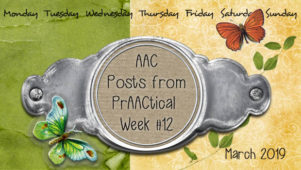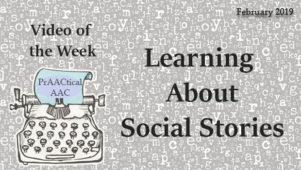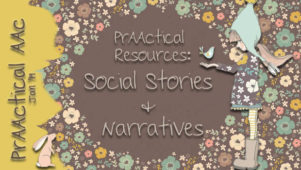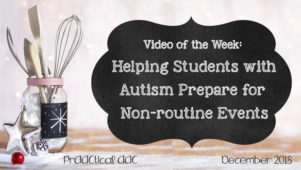PrAACtical Supports- Walking the Walk AAC Style!
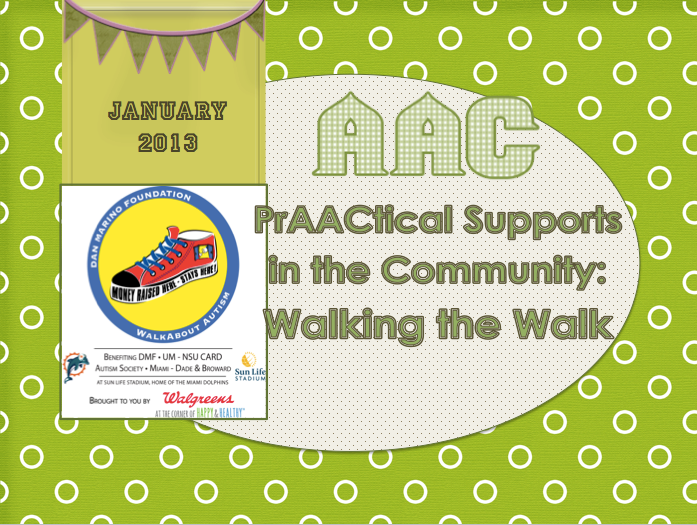
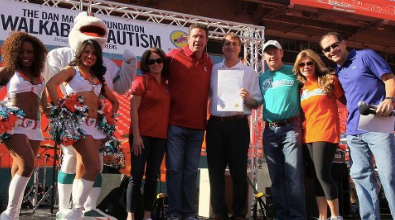 We are extremely proud to be part of the Dan Marino Foundation WalkAbout Autism, which is a large South Florida event. It is a true collaboration between the community, volunteers, sponsors, donors, walk partners, and the Miami Dolphins. The Walkabout helps raise money for organizations that provide programs and services for individuals with autism and other developmental disabilities. It also promotes a sense of community collaboration and awareness about autism spectrum disorder and developmental disabilities. We are writing about the WalkAbout, not as a plea for money (although read about the WalkAbout and donate if you are so inclined), but instead to tell you how we continue to try to integrate AAC & visual strategies into community events. We are so grateful to Dan & Claire Marino and their family and Jeff & Rachel Ireland and their family for continuing to dedicate their time and effort for this amazing event.
We are extremely proud to be part of the Dan Marino Foundation WalkAbout Autism, which is a large South Florida event. It is a true collaboration between the community, volunteers, sponsors, donors, walk partners, and the Miami Dolphins. The Walkabout helps raise money for organizations that provide programs and services for individuals with autism and other developmental disabilities. It also promotes a sense of community collaboration and awareness about autism spectrum disorder and developmental disabilities. We are writing about the WalkAbout, not as a plea for money (although read about the WalkAbout and donate if you are so inclined), but instead to tell you how we continue to try to integrate AAC & visual strategies into community events. We are so grateful to Dan & Claire Marino and their family and Jeff & Rachel Ireland and their family for continuing to dedicate their time and effort for this amazing event.
This past weekend was the 3rd WalkAbout Autism. It was a truly amazing event and day! There was great music, bounce houses, video games, singers, dancers, art activities, food, and much more. We had many University mascots including Razor from Nova Southeastern University, Sebastian from University of Miami, and Owlsley from Florida Atlantic University . They definitely had ‘rock star’ attention throughout the day.
We work very hard to make this a truly inclusive event. We listen each year to the feedback from individuals with autism and to parents of children with autism. We know that with appropriate AAC supports and sensory sensitivity options (and lots of pre-planning), we can have an event that welcomes and educates everyone. We will continue to improve every year because our goal is for full participation and awareness of autism and AAC strategies throughout the community. Here are some of the ways we Walk the Walk AAC Style:
- The PlayBook– Since the WalkAbout is fairly new and does not occur often (unfamiliar), the WalkAbout committee developed a modified social story or as we call it a ‘personal participation story’. On the event website, there are instructions about how the Playbook can be used to understand and plan the WalkAbout Day. Everyone can get an idea about what to expect. Not only do WalkAbout participants become aware and LEARN about modified social stories, so do the designing team, the printer, the sponsors, the vendors, etc. Through the years, more people have learned about the Playbook. Our goals for next year are: 1. to have it on the website earlier, 2. maybe have a few versions so it can be more tailored to an individual, 3. have a digital interactive version, 4. include a WalkAbout communication board, and to have multiple reminders to use it when ‘coaching’ emails go out.
- The Day Planner– A regular activity schedule was not used because events can be experienced in any order and you do not need to do everything to have a great day. Also, new activities were added up to the last-minute and therefore would not have been able to be included. It was felt though some (many) participants might want a plan to follow in order to know what activities were going to be done. Also, by making a schedule a family would have a time frame for how many activities were going to be done before they left the event. Because of this, a blank day planner is included at the end of the Playbook. Anyone can take the planner and look around the Sun Life Stadium and make choices as to what to do. Once the choices were made, they can write, draw, or take pictures to add to the planner. With the day planner, ALL the WalkAbout Autism participants had the opportunity to LEARN about schedules and modified schedules. Many families told us that they read the Playbook and used the planner which is great. But we do have to admit, we did not see many people actually using it the day of the walk. Truthfully though, we may just have been too busy to notice, but maybe next year we could make it a priority to have the volunteers have day planner handouts to give out at the resource tables of the community partners.
-
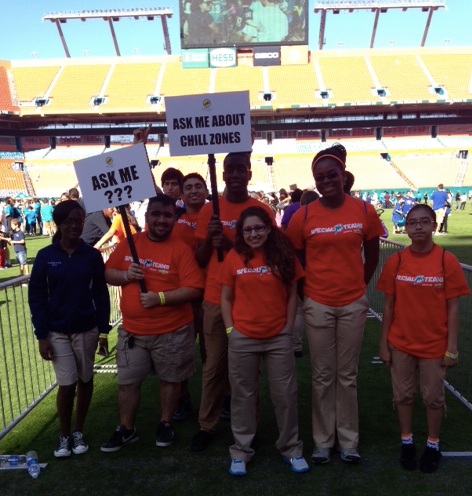 Chill Zones- Since the WalkAbout has many, many participants, it is always great to have a sensory friendly option if the crowds get too overwhelming. The Chill Zones offer a quieter, less crowded, air-conditioned (we live in South Florida and it is usually warm in January) space if needed. The Chill Zone has instructions that were written with text and picture symbols. Volunteers held signs that said ‘ask me about the Chill Zones’. This is the type of support that is great to have, but we kind of hope that nobody needs it. This year was interesting because the Chill Zones were used but not so much. We think they were used more minimally because the South Florida weather was perfect (not too cool, not too hot), the event activities were spread out inside and outside the stadium so there were fewer people in small spaces, and the sound system was set at a reasonable level (this was a huge problem in past years). Some of our volunteers initially felt a little let down because the Chill Zones were less full than in previous years, but more than 20,000 people had awareness of sensory sensitivity supports. And we know it is always better to have supports and not need them, then to not have supports and to have to be without them. We hope that the awareness of sensory friendly environments translates into more supports being used in the community (and we know it is already beginning to happen, as there is a University of Miami, Temple Grandin event that will have a Chill Zone option).
Chill Zones- Since the WalkAbout has many, many participants, it is always great to have a sensory friendly option if the crowds get too overwhelming. The Chill Zones offer a quieter, less crowded, air-conditioned (we live in South Florida and it is usually warm in January) space if needed. The Chill Zone has instructions that were written with text and picture symbols. Volunteers held signs that said ‘ask me about the Chill Zones’. This is the type of support that is great to have, but we kind of hope that nobody needs it. This year was interesting because the Chill Zones were used but not so much. We think they were used more minimally because the South Florida weather was perfect (not too cool, not too hot), the event activities were spread out inside and outside the stadium so there were fewer people in small spaces, and the sound system was set at a reasonable level (this was a huge problem in past years). Some of our volunteers initially felt a little let down because the Chill Zones were less full than in previous years, but more than 20,000 people had awareness of sensory sensitivity supports. And we know it is always better to have supports and not need them, then to not have supports and to have to be without them. We hope that the awareness of sensory friendly environments translates into more supports being used in the community (and we know it is already beginning to happen, as there is a University of Miami, Temple Grandin event that will have a Chill Zone option). 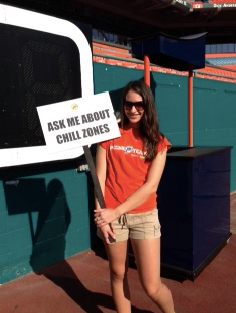
- The Star Spangled Banner– A group of singers with autism spectrum disorder start off the walk with the singing of the Star Spangled Banner. Three of the singers used a natural singing voice and one of the singers used an AAC voice. The song was illustrated in pictures to provide a visual representation of the song meaning and used as AAC symbols. The Song Story was loaded onto the iPad so the AAC user could be active in singing words for the National Anthem. Each page of the story was a singing line from the song. All participants could print out the Star Spangled Banner Visual Story.
Incorporating AAC strategies is only possible because of the support of many, many, many, people. The great news is that we got that support and that means many, many, many people LEARNED. Next year, we will find more ways to ‘Walk the Walk AAC Style’!
Filed under: PrAACtical Thinking
Tagged With: community, schedules, social stories
This post was written by Robin Parker


